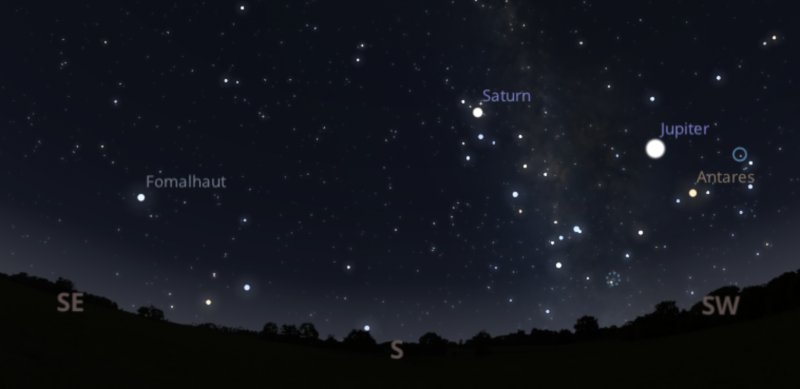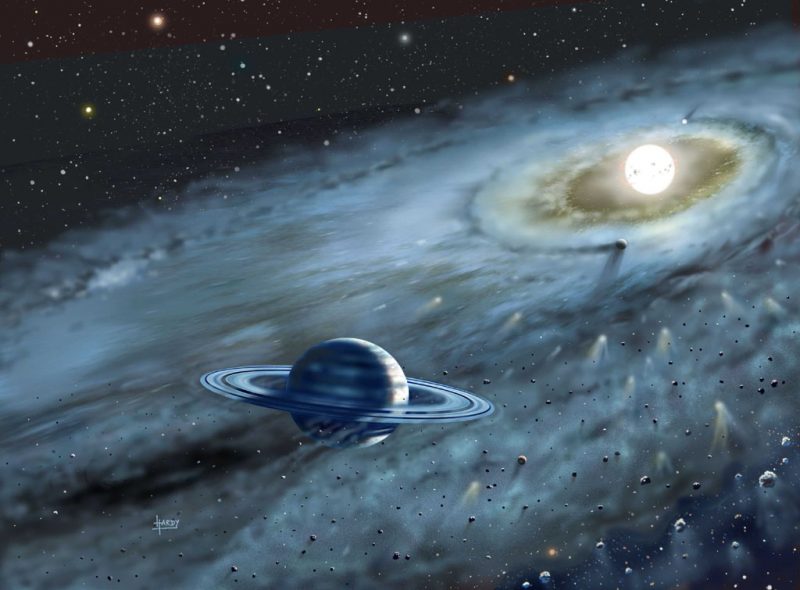

View larger. | Fomalhaut is sometimes called the Loneliest Star because no other bright stars shine near it in the sky. Photo by EarthSky Facebook friend Tony Gieracki. Thank you, Tony!
The star Fomalhaut is sometimes called the Autumn Star by people in the Northern Hemisphere, but it’s a spring star south of the equator. It’s famous in astronomical science as the first star with a visible exoplanet. It appears in a part of the sky that’s largely empty of bright stars. For this reason, in skylore, Fomalhaut is often called the Lonely One or Solitary One. It’s an easy star to spot and one you’ll want to meet.
How to see Fomalhaut. Fomalhaut – the 18th brightest star in the sky – is more or less opposite the sun in early September. And so it shines in the sky all night during the autumn months in the Northern Hemisphere (all night in spring for the Southern Hemisphere). In most years, finding Fomalhaut from latitudes like those in the U.S. is simple. Just face south in mid-evening in autumn and look. Fomalhaut is the brightest star in front of us on autumn evenings, as we face south. It’s typically less than a third of the way up in the sky (higher from far southern Texas or Florida, lower from more northerly locations).
From the Southern Hemisphere. Those at far southern latitudes on Earth see Fomalhaut high in their sky, for more of the year, than we do on the northern part of Earth. For your specific view, try Stellarium online.

For a larger view, and your specific view, see Stellarium online. | This chart shows the view southward around 9 p.m. in mid-September, from the Northern Hemisphere. In 2019, Fomalhaut has company. The 2 bright planets Jupiter and Saturn can be found near it in the sky.
In early September, Fomalhaut reaches its midnight culmination, meaning that it is highest in the sky to the south at local midnight. Finding Fomalhaut at the time it culminates is easiest, but this happens at different times on different dates. Here are just a few times and dates of culmination, but keep in mind that the times are only rough, although they are adjusted for daylight saving time as needed:
July 15, 4 a.m.
August 15, 1 a.m.
September 15, midnight
October 15, 10 p.m.
November 15 , 7 p.m.
December 15, 5 p.m.
Fomalhaut is part of the faint constellation Piscis Austrinus the Southern Fish. It’s part of a round pattern of stars, supposedly the open mouth of the Fish. But don’t expect to see a fish in these stars.
Fomalhaut is probably is the most southerly bright star that many North Americans know. Granted, a few bright stars farther to the south are visible from tropical and subtropic northern latitudes, but these brighter stars lurk near or beneath the horizon as seen as from middle and far northern latitudes in the Northern Hemisphere. Fomalhaut can be seen from as far north as 60 degrees latitude (southern Alaska, central Canada, northern Europe), where it just skims the southern horizon.

Fomalhaut lies in the constellation Piscis Austrinus the Southern Fish. Its name means Mouth of the Fish in Arabic. This irregular circle of stars – visible in a dark sky – represents the fish’s open mouth.

Another representation of Piscis Austrinus and its bright star Fomalhaut via Torsten Bronger/Wikimedia Commons.
Fomalhaut’s planet, Fomalhaut b or Dagon. The star Fomalhaut, which is known to be surrounded by several debris disks, holds a special place in the search for planets beyond our solar system. In 2008, scientists announced a visible planet for Fomalhaut. It was the first extrasolar planet visible to the eye in photographic images. In 2008, when astronomers made this announcement, we knew other planets were out there, orbiting distant suns. But, prior to the images of Fomalhaut b, all extrasolar planets, or exoplanets, made their presence known indirectly, for example, in some instances, by their gravitational tugging on their stars.
Fomalhaut’s planet was confirmed as real in 2012, from images taken with the Hubble Space Telescope (see the image below).
This planet – Fomalhaut b, recently given the name Dagon by the International Astronomical Union as part of its public process for giving proper names to exoplanets. Dagon was a Semitic deity that was half man and half fish.
The planet has a 1,700-year, highly elliptical orbit around its parent star. It has a periastron – that is, a closest point to its star – of 7.4 billion kilometers or 46 billion miles (~50 time the Earth-sun distance) and an apastron (farthest point from its star) of about 44 billion km or 27 billion miles (~300 the Earth-sun distance). According to Wikipedia – as of May 25, 2013 – Dagon is 110 Earth-sun distances from its parent star.
It should be mentioned that there was controversy surrounding the existence of Dagon for some years. You still sometimes see stories disputing that it exists.

View larger. | This false-color composite image, taken with the Hubble Space Telescope, reveals the orbital motion of the planet Fomalhaut b, aka Dagon. Based on these observations, astronomers calculated that the planet is in a 2,000-year-long, highly elliptical orbit. The planet will appear to cross a vast belt of debris around the star roughly 20 years from now. If the planet’s orbit lies in the same plane with the belt, icy and rocky debris in the belt could crash into the planet’s atmosphere and produce various phenomena. The black circle at the center of the image blocks out the light from the bright star, allowing reflected light from the belt and planet to be photographed. The Hubble images were taken with the Space Telescope Imaging Spectrograph in 2010 and 2012. Image via NASA/ ESA/ P. Kalas.
Fomalhaut in history and mythology. Fomalhaut is Alpha Piscis Austrinus (the brightest star in the Southern Fish), and the name Fomalhaut derives from the Arabic Fum al Hut, meaning Mouth of the Fish. Strangely, another Arabic title for the star means The First Frog.
In the sky visible from the Northern Hemisphere, the constellation Aquarius the Water Carrier resides above Fomalhaut’s constellation Piscis Austrinus. You can see a zig-zag line of stars that goes from Aquarius to Piscis Austrinus. In skylore, this line of stars represents water from the Jar of the Water Carrier, trickling into the open Mouth of the Fish, as shown in the illustration below.
According to Richard Hinckley Allen, Fomalhaut was one of the four guardians of the heavens to the ancient Persians, and given the name of Hastorang. (The other guardians were Aldebaran in Taurus, Antares in Scorpius, and Regulus in Leo.) Allen also says that Fomalhaut was a source of worship at the temple of Demeter at Eleusis in ancient Greece. In about 2500 B.C., Fomalhaut helped mark the location of the winter solstice, meaning that it helped to define the location in the sky where the sun crossed the meridian at noon on the first day of winter.

Water from the Water Jar of Aquarius can be seen going into the Mouth of the Southern Fish (located just off the bottom of this chart), in this depiction of these constellations from Urania’s Mirror, 1825. In the actual sky – if it’s dark where you are – you can easily see a zig-zag line of stars representing this flow of water. Chart via Wikimedia Commons.
The star Fomalhaut, and a word about the Main Sequence. As determined by an analysis of its light, Fomalhaut is classified as an A3V star. It’s considerably hotter and heavier than our sun. Imagine you could place our sun and Fomalhaut side by side in space – say, at 10 parsecs or 32.6 light-years away. In that case, Fomalhaut would outshine our sun in visible light by nearly 17 times. The “V” in Fomalhaut’s classification is called a luminosity class, and it designates the largest category of all, ordinary stars like our sun in the mature and stable part of their life spans.
These numbers and letters refer to what astronomers call the Main Sequence, a way of categorizing stars by mass and luminosity. The Main Sequence follows the rather odd progression of OBAFGKM. Os are the hottest and most massive stars, and Ms are the coolest and least massive stars. In addition, there is a numerical subdivision running from 0 to 9 with each letter. Our sun is a G2V, as is Alpha Centauri. Since Fomalhaut’s designation is significantly to the left of the sun’s in this sequence, you know it is hotter and more massive than our sun.
Fomalhaut’s actual distance from Earth, as determined by analysis of data from the Hipparcos mission, is 25 light-years. Fomalhaut’s mass and radius are, respectively, a little more than twice and a little less than twice solar values. Being hotter than the sun (about 8500 kelvins/8227 degrees Celsius or nearly 15,000 degrees F, compared to 10,000 degrees F or 5538 C for the sun), this star burns its fuel faster and has a shorter lifetime. In fact, it is estimated that Fomalhaut may have a lifespan of only about a billion years, a tenth of that of our cooler sun. Currently, Fomalhaut is likely less than halfway through its life.
Fomalhaut appears to the eye to be a single star like the sun, but there is another faint star a couple of degrees below (south of) Fomalhaut that is at about the same distance and moving through space in the same manner. This other star was recently found to be a companion to Fomalhaut, despite the fact that the two stars are separated by about a light-year. In 2013, researchers found that Fomalhaut is actually a triple star. It is one of the widest triple stars known. Read more about the third star in the Fomalhaut system.

Artist’s concept of what a planet orbiting Fomalhaut might have to endure as it plows through the dusty disk around this star. Image via NASA.
Fomalhaut’s position is RA: 22h 57m 39s, dec: -29° 37′ 19″.
Bottom line: Look for the star Fomalhaut in the constellation Piscis Austrinus the Southern Fish on Northern Hemisphere autumn evenings (Southern Hemisphere spring evenings). Because it’s the only bright star in its region of sky, Fomalhaut is sometimes called the Loneliest Star. This star is famous for its planet – Fomalhaut b, now called Dagon – which was the first visible extrasolar planet.
Source:
https://earthsky.org/brightest-stars/solitary-fomalhaut-guards-the-southern-sky